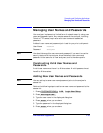
LAN Interface Supplement 1-15
Connecting and Configuring the Analyzer
Using BOOTP
Using BOOTP
BOOTP Fundamentals
The Bootstrap Protocol (BOOTP) is a simple and elegant method of
automatically distributing network information and software via the
LAN. BOOTP is built on the client-server model. The BOOTP client
configures itself using configuration information obtained from a BOOTP
server. Your analyzer has a built-in BOOTP client. The analyzer can use
BOOTP to configure itself automatically, obtaining its network
configuration information (IP address, gateway address, and subnet
mask) from a central BOOTP server over the network. On power up, the
analyzer broadcasts a request to boot from a remote server. If a BOOTP
server is available on the LAN listening for BOOTP client requests, it
transmits configuration parameters to the analyzer over the network.
The analyzer uses those parameters automatically.
BOOTP can also be used to automatically retrieve and execute an IBASIC
program at boot time. The boot file is transferred to the analyzer from
the BOOTP server using FTP or trivial file transfer protocol (TFTP). If the
transfer is successful, the file will be loaded into the analyzer’s memory
and executed. The boot file can be any valid IBASIC program.
Setting Up the BOOTP Server
To use the BOOTP client in your analyzer, you need a BOOTP server
application running on a remote UNIX system or a PC. A BOOTP server,
bootpd (BOOTP daemon), is an integral part of most UNIX operating
systems. You will need to obtain a separate BOOTP server application for
your PC. Consult your network administrator for obtaining a BOOTP
server application for your PC, and for assistance setting up a BOOTP
server.
The following steps are required to use BOOTP:
1. Assure that the analyzer and BOOTP server are not separated by a
gateway. Consult your network administrator if you are not sure.
2. Set up a BOOTP server application on a remote host (UNIX system or
PC). You will need the following information:


















